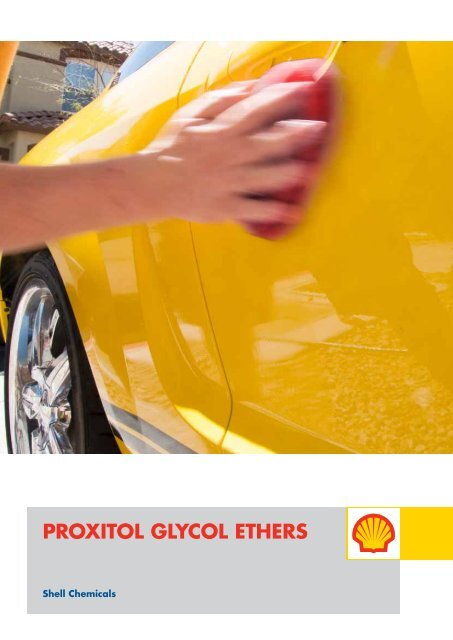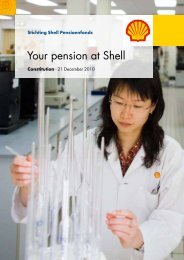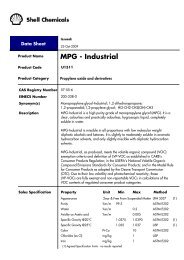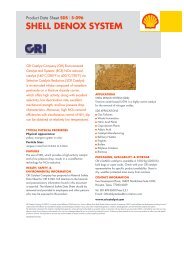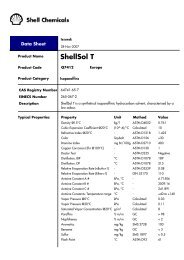You also want an ePaper? Increase the reach of your titles
YUMPU automatically turns print PDFs into web optimized ePapers that Google loves.
<strong>PROXITOL</strong> <strong>glycol</strong> <strong>ethers</strong><br />
Shell Chemicals
2<br />
Proxitol* Glycol Ethers are used in a variety<br />
of applications including:<br />
Coatings<br />
■■<br />
Automotive<br />
■■<br />
Industrial Maintenance<br />
■■<br />
Architectural<br />
■■<br />
Aerospace<br />
■■<br />
Speciality Paints<br />
Cleaners & Inks<br />
■■<br />
All-Purpose<br />
■■<br />
Oven<br />
■■<br />
Industrial<br />
■■<br />
Household<br />
■■<br />
Flexographic<br />
■■<br />
Screen Printing<br />
Electronics<br />
■■<br />
Copper Clad Laminating<br />
■■<br />
Laminates<br />
■■<br />
Photoresistors<br />
Other<br />
■■<br />
Adhesives<br />
■■<br />
Pharmaceuticals<br />
■■<br />
Cosmetics<br />
■■<br />
Industrial Processes<br />
■■<br />
Oil Field Chemicals<br />
■■<br />
Mining Chemicals<br />
■■<br />
Agricultural Chemicals<br />
■■<br />
Textile & Leather Dyes
Proxitol* Glycol Ethers<br />
If you want to know where we can take you,<br />
look at where we’ve been<br />
Shell Chemicals began over 80 years ago. We<br />
have a reputation for a broad product range,<br />
business consulting, technical expertise and<br />
manufacturing excellence. We are one of the<br />
largest petrochemical concerns in the world,<br />
with manufacturing facilities in 13 countries and<br />
marketing hubs in three global regions with<br />
customer service covering 55 countries.<br />
We have been manufacturing and supplying<br />
solvents since the 1920s and are continually<br />
developing new products, often as alternatives<br />
for solvents that are under specific regulatory<br />
pressure. These solvents provide opportunities<br />
for solvent substitution, offering both cost<br />
effectiveness and equivalent performance.<br />
We are able to draw upon our years of<br />
experience in the solvents business, providing<br />
assistance and information to customers<br />
regarding solvent selection, solvent regulations<br />
and general health, safety and environmental<br />
issues. It is this commitment and customer<br />
focus that has allowed us to become and<br />
remain an industry leader.<br />
We’re providing you with alternative solvents<br />
<strong>PROXITOL</strong>* Glycol Ethers<br />
Technical Equivalency<br />
Shell Chemicals produce propylene <strong>glycol</strong><br />
and three <strong>glycol</strong> ether derivatives in Europe at<br />
Pernis, NL, which are commercially available<br />
on a global basis. These propylene <strong>glycol</strong><br />
<strong>ethers</strong> provide alternatives to the <strong>ethers</strong> of<br />
ethylene <strong>glycol</strong>s, which are under regulatory<br />
pressures around the world.<br />
Methyl <strong>PROXITOL</strong> <strong>glycol</strong> ether is the methyl<br />
ether of propylene <strong>glycol</strong> (PM), and Methyl<br />
<strong>PROXITOL</strong> <strong>glycol</strong> ether acetate is the acetate<br />
of the methyl ether of propylene <strong>glycol</strong> (PMA).<br />
The chemical structures and the names of<br />
technically equivalent products for these<br />
<strong>PROXITOL</strong> <strong>glycol</strong> ether solvents are given in<br />
Figure 1. Shell Chemicals <strong>PROXITOL</strong> <strong>glycol</strong><br />
ether solvents meet or exceed competitor and<br />
industry specifications for these products,<br />
including ASTM Specification D4837 for PM<br />
and ASTM Specification D4835 for PMA.<br />
* <strong>PROXITOL</strong> is a trademark of the Royal Dutch/Shell Group of companies
4<br />
Figure 1<br />
Names of Technically Equivalent Products<br />
Shell<br />
Methyl<br />
<strong>PROXITOL</strong>*<br />
Glycol Ether<br />
Methyl<br />
Di<strong>PROXITOL</strong>*<br />
Glycol Ether<br />
Methyl<br />
<strong>PROXITOL</strong>*<br />
Glycol Ether<br />
Acetate<br />
Ethyl <strong>PROXITOL</strong>*<br />
Glycol Ether<br />
Abbreviation PM DPM PMA EP or PE<br />
Common<br />
Chemical Name<br />
Propylene <strong>glycol</strong><br />
Monomethyl ether<br />
Di-Propylene <strong>glycol</strong><br />
Monomethyl ether<br />
Propylene <strong>glycol</strong><br />
Monomethyl ether<br />
acetate<br />
Propylene <strong>glycol</strong><br />
monoethyl ether<br />
Scientific Name<br />
1-methoxy-2-<br />
propanol<br />
1-(2-methoxy-1-<br />
methylethoxy)-2-<br />
propanol<br />
1-methoxy-2-<br />
propanol acetate<br />
1-ethoxy-2-propanol<br />
Dow DOWANOL ® PM Dowanol ® DPM DOWANOL ® PMA DOWANOL ® EP<br />
LyondellBasell ARCOSOLV ® PM ARCOSOLV ® DPM ARCOSOLV ® PMA ARCOSOLV ® PE<br />
Eastman<br />
EKTASOLVE ® PM<br />
or EASTMAN ® PM<br />
n/a<br />
EKTASOLVE ® PMA<br />
or EASTMAN ® PMA<br />
EKTASOLVE ® EP<br />
or EASTMAN ® EP<br />
Chemical<br />
Structure<br />
CH 3<br />
-O-CH 2<br />
-CH-OH CH 3<br />
O[CH 2<br />
CH(CH 3<br />
)O] 2<br />
H CH 3<br />
-O-CH 2<br />
-CH-O-C-CH 3<br />
CH 3<br />
-CH 2<br />
-O-CH 2<br />
-CH -OH-CH 3<br />
CH 3<br />
CH 3<br />
O
Proxitol* Glycol Ethers<br />
Safety and Regulatory Advantages<br />
As shown in Figure 2, unlike the <strong>ethers</strong> of ethylene <strong>glycol</strong>, the <strong>PROXITOL</strong> <strong>glycol</strong> ether solvents<br />
are not listed as ‘Hazardous Air Pollutants’ (HAPS) under the US Federal Clean Air Act of<br />
1990 and its subsequent amendments. They are not reportable under SARA Title 313, nor are<br />
they included in California’s Proposition 65 lists of chemicals. In addition, they have higher<br />
workplace exposure limits than equivalent ethylene <strong>glycol</strong> <strong>ethers</strong>. These regulatory advantages<br />
for propylene <strong>glycol</strong> <strong>ethers</strong> have contributed to their significant market growth in the US.<br />
Figure 2<br />
Health, Safety and Environment Comparison<br />
HAP SARA 313 CA PROP. 65 ACGIH † TLV PPM<br />
Propylene Glycol Monomethyl<br />
Ether (PM)<br />
Propylene Glycol Monomethyl<br />
Ether Acetate (PMA)<br />
Dipropylene Glycol<br />
Monomethyl Ether (DPM)<br />
Ethylene Glycol Monomethyl<br />
Ether (EM)<br />
Ethylene Glycol Monoethyl<br />
Ether (EE)<br />
Ethylene Glycol Monoethyl<br />
Ether Acetate (EEA)<br />
Ethylene Glycol Monobutyl<br />
Ether (EB)<br />
Ethylene Glycol Monobutyl<br />
Ether Acetate (EBA)<br />
Diethylene Glycol Monobutyl<br />
Ether (DB)<br />
No No No 100<br />
No No No NE<br />
No No No 100<br />
Yes Yes Yes 5<br />
Yes Yes Yes 5<br />
Yes Yes Yes 5<br />
No Yes No 20<br />
Yes Yes Yes 25<br />
No Yes No NE<br />
†<br />
ACGIH – American Conference of Governmental Industrial Hygienists
6<br />
Coatings Applications<br />
The primary market for <strong>PROXITOL</strong> <strong>glycol</strong> <strong>ethers</strong> is within the coatings industry. The variety of<br />
coatings end uses, as well as other markets for <strong>PROXITOL</strong> <strong>glycol</strong> <strong>ethers</strong> are shown in Figure 3.<br />
The <strong>PROXITOL</strong> <strong>glycol</strong> <strong>ethers</strong> solvents have high solvencies and are slow evaporating solvents.<br />
<strong>PROXITOL</strong> <strong>glycol</strong> <strong>ethers</strong> solvents have properties similar to the methyl (EM) and ethyl (EE) <strong>ethers</strong><br />
of ethylene <strong>glycol</strong> and to the acetate of EE (EEA) (Figure 4). Although the <strong>PROXITOL</strong> <strong>glycol</strong><br />
<strong>ethers</strong> evaporate slightly faster (Figure 5), in most applications PM and DPM can be used<br />
to substitute for EM or EE, and DPM and PMAc can be substituted for EEA; PM and DPM is<br />
compatible with a variety of resins, including epoxies and polyesters, and PMA is also used<br />
extensively with acrylic and urethane resins.<br />
Figure 3<br />
Proxitol Glycol Ethers have multiple end uses<br />
Coatings<br />
Automotive, Industrial Maintenance, Coil, Appliance & Equipment,<br />
Lacquer & Stains, Architectural, Marine, Aerospace, Plastic Primer,<br />
Resin Formulations, Colorants, Thinners, Speciality Paints<br />
Cleaners & Inks<br />
All-Purpose, Glass, Oven, Industrial, Household, Gravure,<br />
Flexographic, Screen Printing, Offset Printing<br />
Electronics<br />
Copper Clad Laminating, Laminates, Photoresistors<br />
Other<br />
Adhesives, Intermediates, Fuel Additives, Pharmaceuticals,<br />
Cosmetics, Industrial Processes, Oil Field Chemicals, Mining<br />
Chemicals, Agricultural Chemicals, Textile & Leather Dyes
Proxitol* Glycol Ethers<br />
Figure 4<br />
Comparison of Typical Properties<br />
MW<br />
Boiling Pt.<br />
°C (°F)<br />
Flash Pt.<br />
°C (°F)<br />
Evap. Rate<br />
(BuAc = 1)<br />
Evap. Time,<br />
seconds<br />
Density Kg/1<br />
(Lb/gal.)<br />
@ 20°C<br />
PM 90 120 (248) 30 (86) 0.75 600 0.921 (7.69)<br />
PMA 132 146 (295) 45 (113) 0.33 1,410 0.967 (8.07)<br />
DPM 148 191 (376) 79 (174) 0.04 13,000 0.953 (7.95)<br />
EM 76 123 (253) 38 (101) 0.53 884 0.963 (8.04)<br />
EP 104 132 (270) 42 (108) 0.49 960 0.896 (7.48)<br />
EE 90 135 (275) 43 (109) 0.38 1,213 0.929 (7.75)<br />
EEA 132 153 (307) 52 (126) 0.20 2,533 0.972 (8.11)<br />
EB 118 171 (340) 61 (142) 0.08 6,750 0.900 (7.51)<br />
EBA 160 186 (367) 160 (320) 0.03 14,310 0.939 (7.84)<br />
DB 162 230 (446) 110 (230)
8<br />
Chemical Properties<br />
PM is completely water-soluble and is also compatible with many greases, oils and waxes,<br />
which makes PM an excellent coupling agent. The manner in which PM partitions between<br />
an organic and water phase, as shown in Figure 6, can be significant in cleaning applications.<br />
Figure 6<br />
Comparison of Solvency Properties<br />
Hildebrand Solubility<br />
Parameter (cal/cm 3 ) 1 / 2<br />
Fractional<br />
Polarity<br />
Solubility in Water<br />
@ 20°C<br />
Partition<br />
Coefficient †† K<br />
PM 9.5 0.110 Complete 0.17<br />
PMA 8.5 0.090 23% –<br />
DPM 8.7 0.050 Complete 0.064<br />
EM 10.8 0.126 Complete 0.001<br />
EP 9.0 0.080 Complete –<br />
EE 9.9 0.086 Complete 0.01<br />
EEA 8.7 0.073 25% –<br />
EB 9.1 0.048 Complete 1.15<br />
EBA 8.2 0.060 1% (25°C) –<br />
DB 8.9 0.0028 Complete –<br />
††<br />
Partition Coefficients in a cyclohexane/water mixture @ 25°C, K = (organic)/(water)
Proxitol* Glycol Ethers<br />
For further information on <strong>PROXITOL</strong> Glycol Ethers or any other Shell Chemicals product,<br />
including product technical data sheets, Safety Data Sheets, and contact information, please<br />
visit our website at www.shell.com/chemicals .<br />
*<strong>PROXITOL</strong> is a trademark of the Royal Dutch/Shell Group of companies.<br />
Each of the companies which make up the Shell Group of companies (the ‘Shell Group’ or the ‘Group’) is an independent entity and has its<br />
own separate identity. In this publication you will find the terms ‘Shell’, ‘Shell Chemicals’, ‘we’ ‘our’ and ‘us’. They should be read in their context.<br />
They may refer to the Group as a whole: they may refer to one or more companies within the Group. Or they may refer to people who work for<br />
a particular Shell company or companies in a particular geographical area or in a particular area of business in which Shell companies engage.<br />
The terms ‘Shell Chemicals’ and ‘Shell chemicals companies’ collectively refer to the companies of the Group that are individually engaged in the<br />
chemicals business.<br />
SC:2885-11


